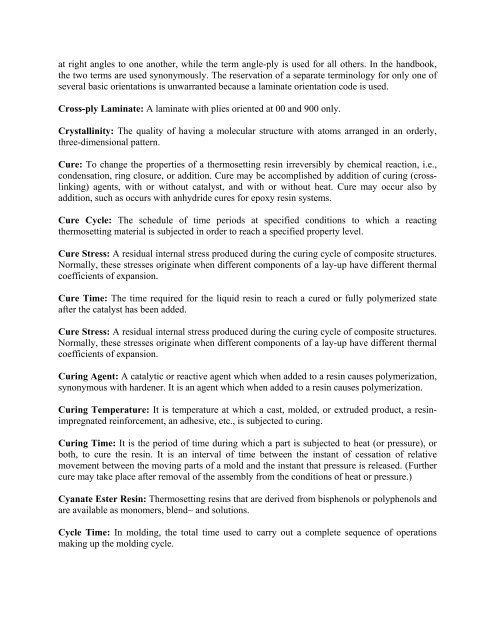Definitions /Dictionary/Glossary - nptel
Definitions /Dictionary/Glossary - nptel
Definitions /Dictionary/Glossary - nptel
Create successful ePaper yourself
Turn your PDF publications into a flip-book with our unique Google optimized e-Paper software.
at right angles to one another, while the term angle-ply is used for all others. In the handbook,<br />
the two terms are used synonymously. The reservation of a separate terminology for only one of<br />
several basic orientations is unwarranted because a laminate orientation code is used.<br />
Cross-ply Laminate: A laminate with plies oriented at 00 and 900 only.<br />
Crystallinity: The quality of having a molecular structure with atoms arranged in an orderly,<br />
three-dimensional pattern.<br />
Cure: To change the properties of a thermosetting resin irreversibly by chemical reaction, i.e.,<br />
condensation, ring closure, or addition. Cure may be accomplished by addition of curing (crosslinking)<br />
agents, with or without catalyst, and with or without heat. Cure may occur also by<br />
addition, such as occurs with anhydride cures for epoxy resin systems.<br />
Cure Cycle: The schedule of time periods at specified conditions to which a reacting<br />
thermosetting material is subjected in order to reach a specified property level.<br />
Cure Stress: A residual internal stress produced during the curing cycle of composite structures.<br />
Normally, these stresses originate when different components of a lay-up have different thermal<br />
coefficients of expansion.<br />
Cure Time: The time required for the liquid resin to reach a cured or fully polymerized state<br />
after the catalyst has been added.<br />
Cure Stress: A residual internal stress produced during the curing cycle of composite structures.<br />
Normally, these stresses originate when different components of a lay-up have different thermal<br />
coefficients of expansion.<br />
Curing Agent: A catalytic or reactive agent which when added to a resin causes polymerization,<br />
synonymous with hardener. It is an agent which when added to a resin causes polymerization.<br />
Curing Temperature: It is temperature at which a cast, molded, or extruded product, a resinimpregnated<br />
reinforcement, an adhesive, etc., is subjected to curing.<br />
Curing Time: It is the period of time during which a part is subjected to heat (or pressure), or<br />
both, to cure the resin. It is an interval of time between the instant of cessation of relative<br />
movement between the moving parts of a mold and the instant that pressure is released. (Further<br />
cure may take place after removal of the assembly from the conditions of heat or pressure.)<br />
Cyanate Ester Resin: Thermosetting resins that are derived from bisphenols or polyphenols and<br />
are available as monomers, blend~ and solutions.<br />
Cycle Time: In molding, the total time used to carry out a complete sequence of operations<br />
making up the molding cycle.
















